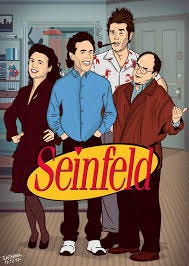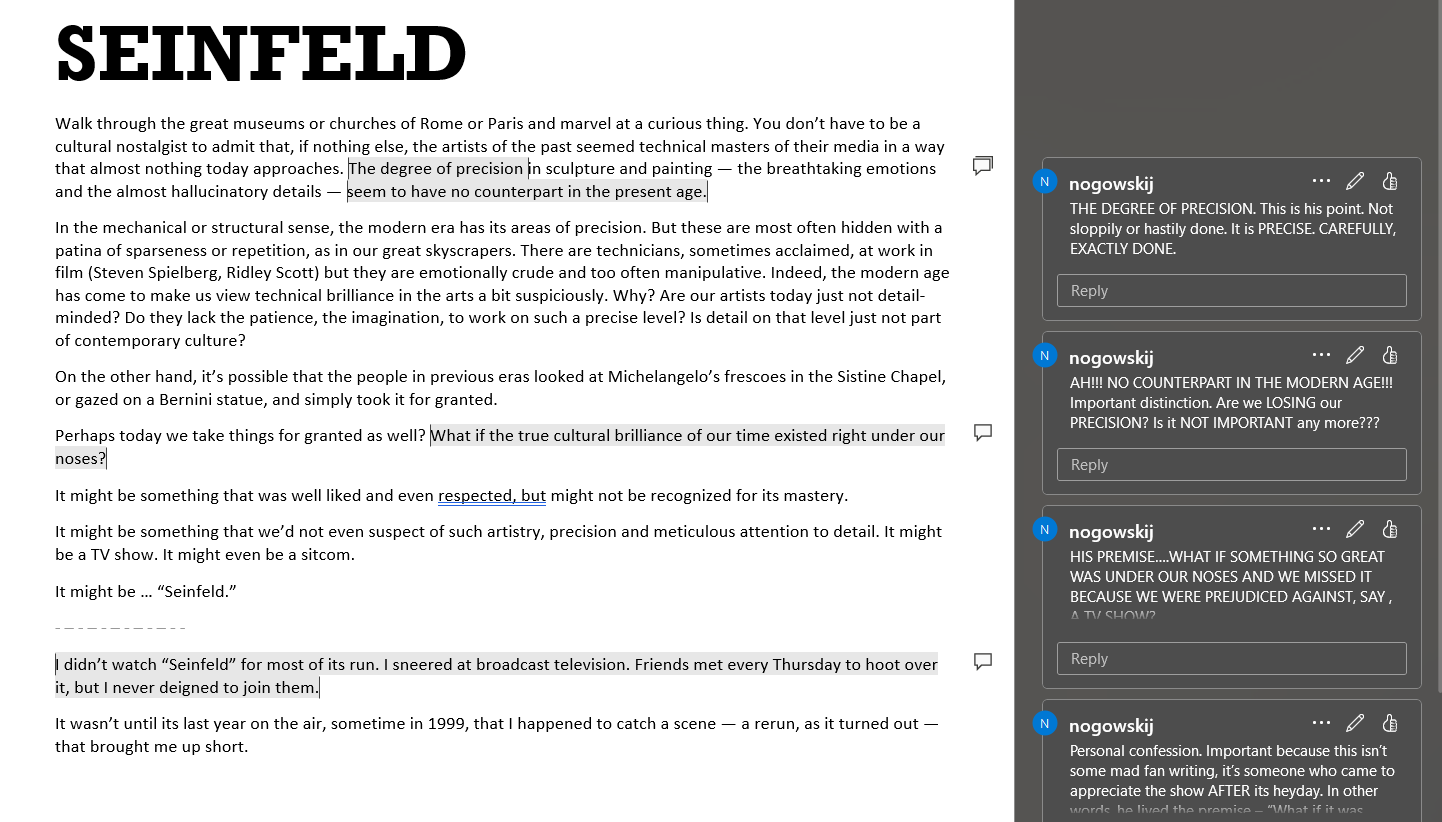Phone rings. “Features.”
“It’s Wyman.”
“What is it now? We’ve been waiting. We need artwork ideas. We’re sitting on our thumbs. Just write the damn thing will ya?”
“Started. But…”
“But what? Where we going now, Wyman? New Jersey? Machu Picchu?”
“Close. Rome.”
“ROME? This is a feature story on the “Seinfeld” series for Crissakes. Closest they got to Rome was Peppy’s Pizza.”
“Uh, Rome and Michaelangelo. Bernini statues. Sistine Chapel.”
“(UNPRINTABLE!) This is a story about a SITCOM, isn’t it? Where are you going with this? What is wrong with you?”
I don’t know for certain that veteran music writer Bill Wyman, not the former Rolling Stones’ bassist, got this kind of reception from whoever the lucky soul was that got to edit his Seinfeld story back in 2002 for the online site, Salon. Talk about taking a flyer, Wyman took the Concorde.
Comparing an American sitcom, even a well-made one, to legendary artistic treasures like the Sistine Chapel and Bernini statues is about as far afield as any writer would dare to go. I sort of half-gagged when I read it myself. You can’t teach taste.
But Wyman’s point, an across-the-centuries reach to talk about precision, about being exact, constructing something as low-brow as an American situation comedy with the kind of frame-to-frame care that you’d take to disassemble an atomic bomb, was a bold idea. Of course, there was the chance that he was as full of shit as a fledgling full-of-himself writer who once espied an amateur sparring match through the eyes of Nathaniel Hawthorne after having read and was mesmerized by “Young Goodman Brown” but he had a West Virginian as an editor who would later kindly explain that he “saved him from himself.” Wyman didn’t.
Yet, I do think he pulled it off. With a rather large grain of salt, a small boulder, really perhaps. But if a teacher was to acquire across-the-board buy-in, like from the not-so-gullible denizens of an AP Literature class that he had attempted to lift to the stratosphere from the start of class, he had no choice but to bring in the big guns — line-by-line annotation. Or the same kind of scrutiny Wyman put all — or almost all — 180 episodes of “Seinfeld” through to determine just how precise, how particular the very particular Jerry Seinfeld and Larry David would be with their scripts, their on-stage mannerisms and the overall enduring quality of the final product.
Were their shows and stories up to microscopic examination, episodes that would thrive and endure and could still be found on the airwaves three, four times in a single day some 27 years after the final show appeared and the cast had drifted off to other projects and new lives?
More than any other single program in the history of television, “Seinfeld” seemed to meet that challenge and is still meeting it day-by-day, week-by-week on into what must feel like television infinity. The question remained, was it the craft, the precision of the comedy, each show fitting together like an expertly crafted, hand-tooled 22-minute Rubix cube, yet the laughs remained.
Was it precision, exactitude with a generally untamed, unsettling beast called comedy, honed to a fine point again and again? Using that annotative board, that line-by-line examination, we would discuss it, critique it, attempting to enlighten these young and curious minds to the wonder, the joy of precision.
What in the world did we talk about? What was the experience of a class on Seinfeld like? I’ve downloaded Wyman’s entire article and my annotations for you, just like we were in class and ready to discuss. (Here’s just a small sample)
If you’d like to dive in further, read the whole article and the annotations that went along with it, they’re all here in the Download. I welcome you to check it out and see what you find as you join with us on this most unusual exploration. Welcome to Nogo’s newly interactive classroom where precision and revision, discussion and concussion about a legendary American sitcom reigned for a day or two?
Where do you go to get an education? Wherever it will lead you… Welcome, friends!




So glad to see some love for the final episode. You’re spot on, of course. I’ve always thought it was great, and could never understand how so many misunderstood what Larry David was doing there.
Putting Seinfeld next to Michelangelo... that sounds sacrilegious enough to warrant its own episode. On the other hand, I'm deep into Ada Palmer's fun and eye-opening (in a historical sense) book "Inventing the Renaissance" which peels a lot of plaster off our concepts of the past. Behind the perfection we perceive when looking back lies a pretty chaotic time and place. Yada, yada, yada.